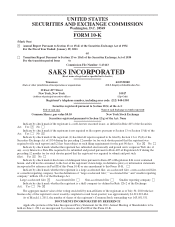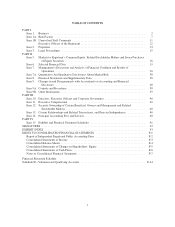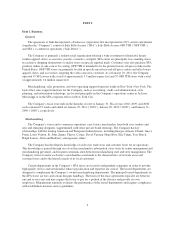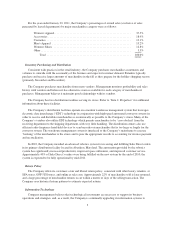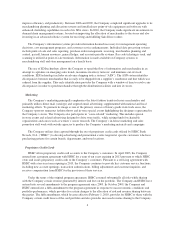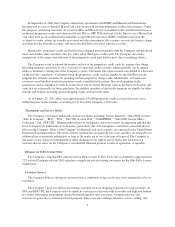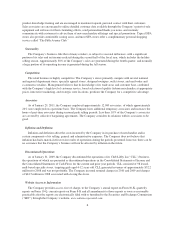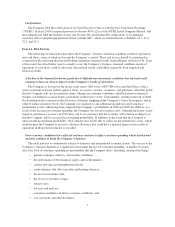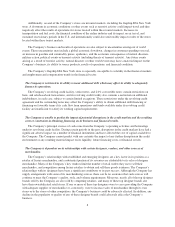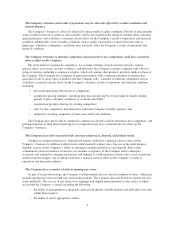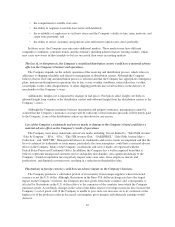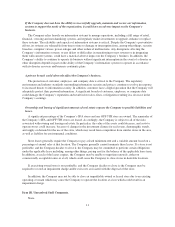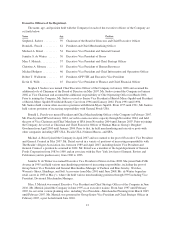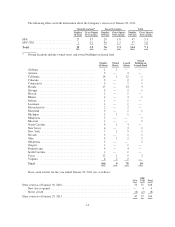Saks Fifth Avenue 2010 Annual Report Download - page 5
Download and view the complete annual report
Please find page 5 of the 2010 Saks Fifth Avenue annual report below. You can navigate through the pages in the report by either clicking on the pages listed below, or by using the keyword search tool below to find specific information within the annual report.improve efficiency and productivity. Between 2006 and 2009, the Company completed significant upgrades to its
merchandising planning and allocation systems and installed new point-of-sale equipment and software with
enhanced clienteling capabilities in each of its SFA stores. In 2010, the Company made significant investments in
demand chain management systems, focused on improving the allocation of merchandise to the stores and also
investing in an advanced robotics system for receiving and fulfilling Saks Direct orders.
The Company’s information systems provide information deemed necessary for management operating
decisions, cost management programs, and customer service enhancements. Individual data processing systems
include point-of-sale and sales reporting, purchase order management, receiving, merchandise planning and
control, payroll, human resources, general ledger, and accounts payable systems. Bar code ticketing is used, and
scanning is utilized at point-of-sale terminals. Information is made available on Company systems to
merchandising staff and store management on a timely basis.
The use of EDI technology allows the Company to speed the flow of information and merchandise in an
attempt to capitalize on emerging sales trends, maximize inventory turnover, and minimize out-of-stock
conditions. EDI technology includes an advance shipping notice system (“ASN”). The ASN system identifies
discrepancies between merchandise that is ready to be shipped from a supplier’s warehouse and that which was
ordered from the supplier. This early identification provides the Company with a window of time to resolve any
discrepancies in order to speed merchandise through the distribution facilities and into its stores.
Marketing
The Company’s marketing principally emphasizes the latest fashion trends in luxury merchandise and
primarily utilizes direct mail (catalogs) and targeted email advertising, supplemented with national and local
marketing efforts. To promote its image as one of the primary sources of luxury goods in its trade areas, the
Company sponsors numerous fashion shows and in-store special events highlighting the designers represented in
the Company’s stores. The Company also participates in “cause-related” marketing. This includes special
in-store events and related advertising designed to drive store traffic, while raising funds for charitable
organizations and causes such as women’s cancer research. The Company’s in-house marketing and sales
promotion staff work with outside agencies to produce the Company’s marketing materials and campaigns.
The Company utilizes data captured through the use of proprietary credit cards offered by HSBC Bank
Nevada, N.A. (“HSBC”) to develop advertising and promotional events targeted at specific customers who have
purchasing patterns for certain brands, departments, and store locations.
Proprietary Credit Cards
HSBC offers proprietary credit card accounts to the Company’s customers. In April 2003, the Company
entered into a program agreement with HSBC for a term of ten years expiring in 2013 pursuant to which HSBC
owns and issues proprietary credit cards to the Company’s customers. Pursuant to a servicing agreement with
HSBC with a ten-year term expiring in 2013, the Company continues to provide key customer service functions,
including new account openings, transaction authorizations, billing adjustments and customer inquiries, and
receives compensation from HSBC for the provision of these services.
Under the terms of the original program agreement, HSBC assumed substantially all risks while sharing
with the Company certain revenue generated by interest and fees on the portfolio. The Company and HSBC have
entered into several amendments to the program agreement since 2003. In October 2009, the Company and
HSBC entered into a fifth amendment to the program agreement in response to macroeconomic conditions and
portfolio performance, which provides for certain changes to the allocation of risk and revenue sharing between
the parties. The fifth amendment, which became effective February 1, 2010, provides for HSBC to share with the
Company certain credit losses of the card portfolio and also provides increased revenue sharing to the Company.
4

